Garden Pros: Attract Butterflies to Your Yard with These Easy-Care Flowers
Nothing adds beauty to a summer garden like fluttering butterflies! The winged wonders make any outdoor area buzz with life and excitement. And watching them flit from flower to flower can give your mind a chance to refresh. Interesting research points out that being a state of "soft fascination" gives your brain a chance to renew itself on a biological level. Thankfully, inviting these lovelies to your space is as easy as planting a butterfly garden — a garden filled with plants that attract and support butterflies. The butterflies will feast off the nectar of the plants’ brightly hued blooms and their young will hatch and feed on the leaves. What’s more, the beneficial insects will cross-pollinate your plants for a healthy and thriving garden. Read on for 10 expert-approved plants that are perfect for creating a butterfly garden in your own backyard.
Choosing plants for a butterfly garden
“Butterflies are attracted to flowers that are brightly colored, favoring shades of red, orange, purple, yellow and pink the most,” says Kim Eierman, founder of EcoBeneficial LLC and author of The Pollinator Victory Garden (Buy on Amazon, $16.69). They feed off the blooms’ sweet nectar to help them thrive, and they pick up and transfer pollen from one flower to another. This cross-pollination process encourages plants to grow and reproduce, resulting in a successful seasonal garden.
What's more, adds gardening pro Rhonda Fleming Hayes, author of Pollinator-Friendly Gardening, these pretty plants and the butterflies they attract make your yard more inviting to human visitors too! “Showcasing a variety of vibrant blooms will invite pollinators like hummingbirds and butterflies right into your yard. This turns any nook into a lovely, lively oasis for relaxing."
In addition to nectar-rich plants, butterflies also flock to plants with leaves that are capable of supporting butterfly larvae. Butterflies lay eggs on the leaves and those eggs eventually hatch into caterpillars that will feed on the leaves of the plant until they are ready to form in their chrysalis and hatch into beautiful butterflies.
Eierman suggests choosing nectar-rich, larvae-supporting plants that are regional to where you live. Not sure what butterfly garden plants are regional to you? Check out North American Butterfly Association’s Regional Butterfly Garden Guides. Here, the 10 best plants for attracting butterflies:
Purple coneflower (Echinacea purpea)
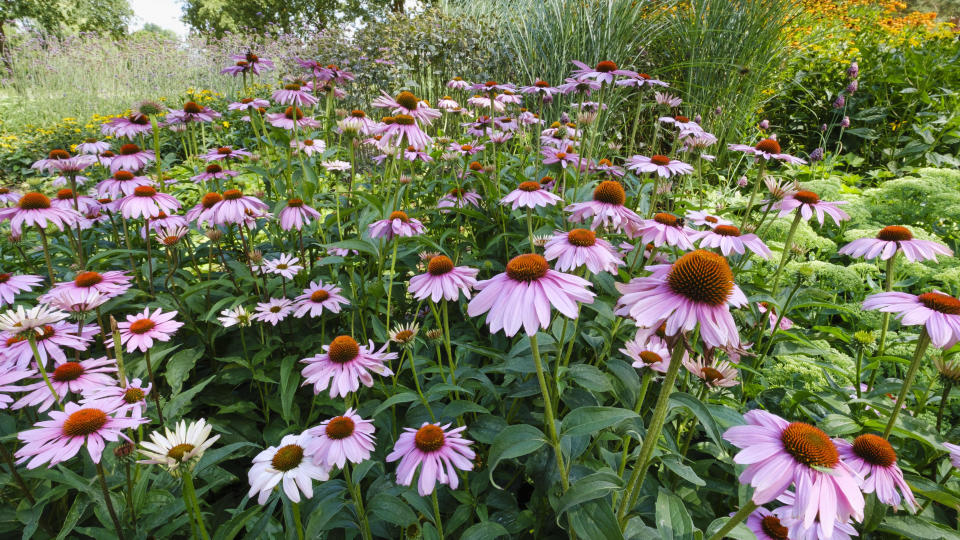
Coneflowers' sturdy structure and up to 6-inch-wide, daisy-like purple blooms create a perfect landing pad for butterflies. Because coneflowers grow up to 5 feet high, they extend beautifully along a fence to hide a bland view. What’s more? Once the blooms are spent for the season, their seed-filled cone centers attract hungry songbirds during the winter months, bringing interest and beauty to your outdoor space year-round. Finally, coneflowers are perennials, meaning they'll bloom year after year and require relatively little attention. (Click through for more low-maintenance perennials to add to your garden.)
USDA Hardiness Zones: 3–8
Soil conditions: Well-draining soil
Sun requirements: Give full sun
Watering schedule: Water once or twice per week when soil is on the dry side
Dense Blazing Star (Liatris spicata)
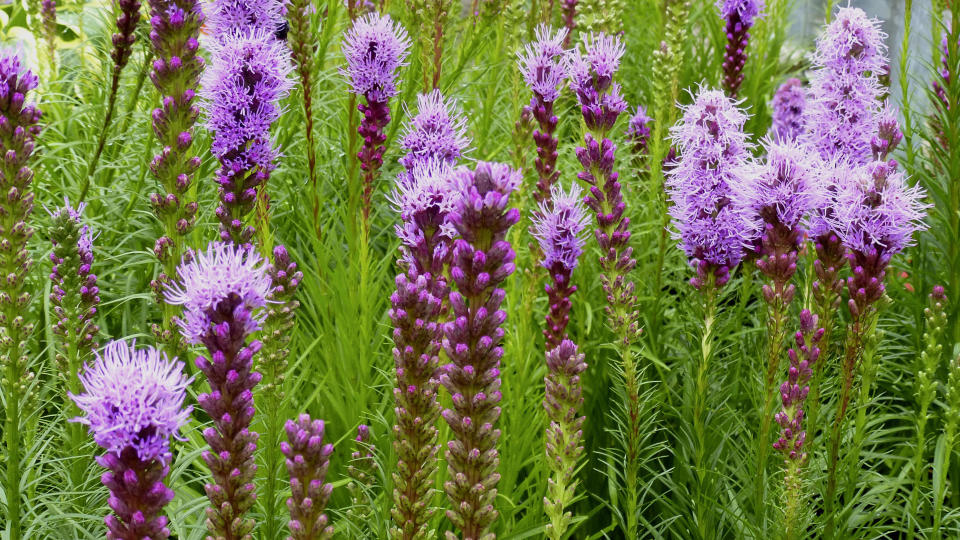
Dense Blazing Stars are known for their showy star-shaped purple flowers that burst from tall and spiky grassy stems, creating layers of eye-catching interest in a garden bed when they bloom starting in mid-to-late summer. The plants grow from 36 to 60 inches tall and their electric-hued flowers are full of sweet nectar that butterflies can’t resist drinking up. Once established, Dense Blazing Star is deer-resistant.
USDA Hardiness Zones: 3–9
Soil conditions: Medium moist, well-draining soil
Sun requirements: Give full to half sun
Watering schedule: Water once weekly; avoid overwatering
Butterfly Weed (Asclepias tuberosa)

Butterflies are drawn to the orange butterfly weed — a plant that’s much prettier than its name suggests! The flowers provide nectar to butterflies and their leaves are the premiere food source for caterpillars of a wide variety of butterfly species. Their small yet dazzling clusters of saturated orange flowers add sunset-like color to your space, and once plants are established, they are drought-tolerant and essentially take care of themselves.
USDA Hardiness Zones: 3–9
Soil conditions: Well-draining or dry soil
Sun requirements: Give full sun
Watering schedule: Only water when soil is dry to the touch
Purple Joe-Pye Weed (Eutrochium purpureum)
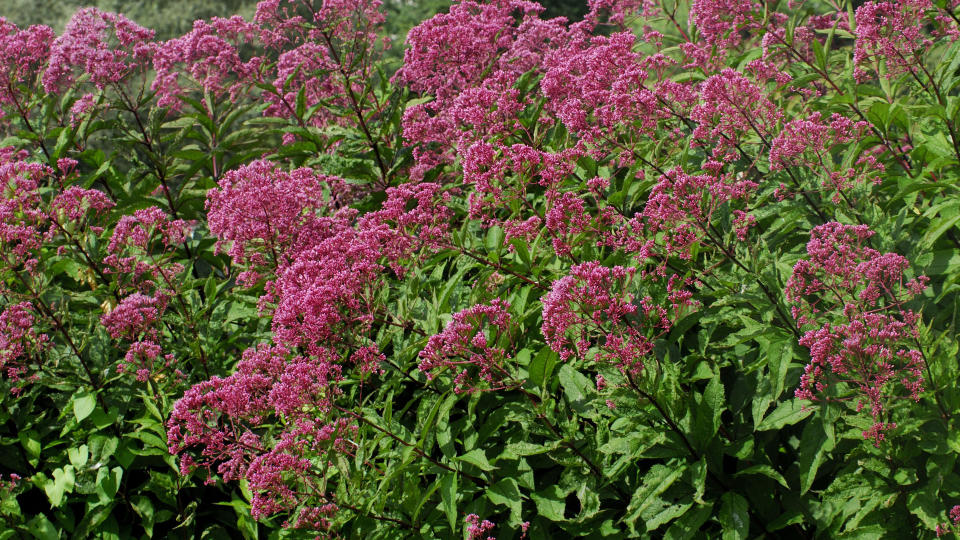
With pretty mauve-pink blooms, a delicious vanilla aroma and abundant nectar, it's no surprise that Purple Joe-Pye Weed is a favorite butterfly garden plant among both humans and the flying beauties, especially Monarchs. Its later bloom time (from late summer to early fall) makes it an essential food source to butterflies and other pollinators in search of nectar when many other plants’ blooms are already spent for the season. The plants are deer- and rabbit-resistant and perfect for filling up large flower beds, since their blooms will spread and grow 3 to 6 feet tall and wide.
USDA Hardiness Zones: 4–8
Soil conditions: Medium moist soil
Sun requirements: Give full sun
Watering schedule: Water once weekly
Giant Ironweed (Vernonia gigantea)
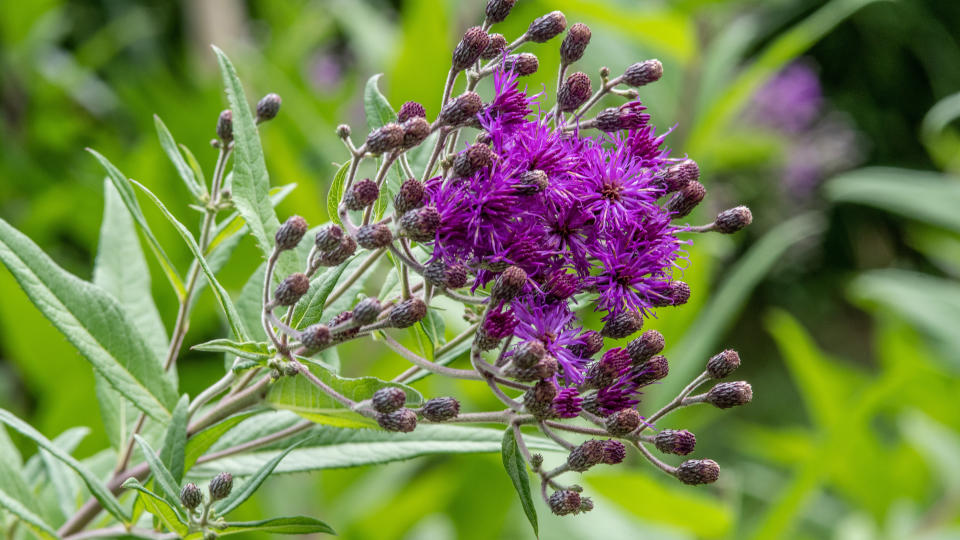
True to their name, Giant Ironweed plants reach very tall heights of 10 feet or more and because of this, make a beautiful backdrop to a border planting. Their masses of bitty yet bountiful magenta blooms appear in late summer through fall and are an excellent late-season nectar source for butterflies. They are a known host for the caterpillars of American Lady butterflies.
USDA Hardiness Zones: 5–8
Soil conditions: Moist soil
Sun requirements: Full to part sun
Watering schedule: Water once weekly
Garden Phlox (Phlox paniculata)
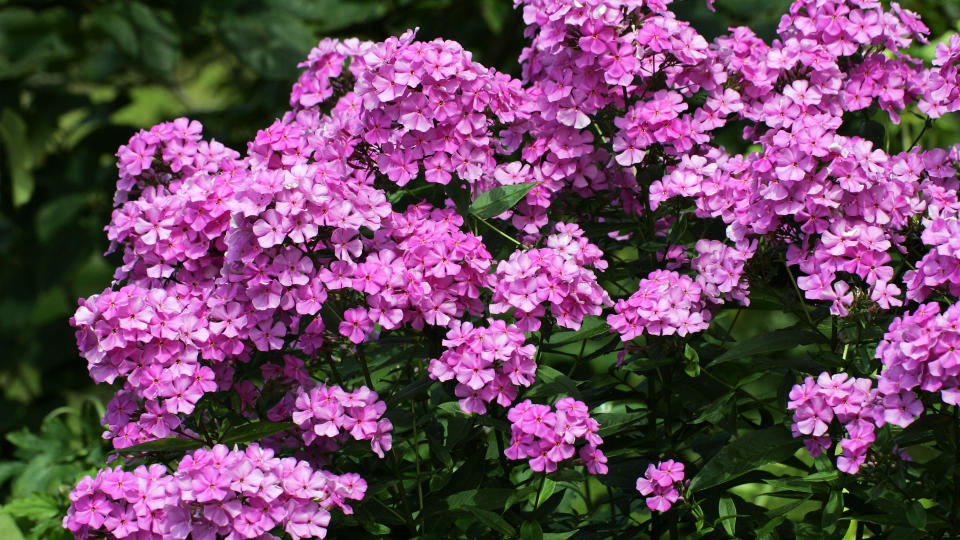
From its pretty clusters of dainty petaled blooms to its sweet and light floral scent, Garden Phlox is a lower-profile, yet spectacular butterfly-friendly plant that is perfect for lining borders and walkways. Its lovely aroma attracts butterflies of many varieties — especially Swallowtails, Sulphurs and Skippers — and they enjoy feasting from the nectar-rich blooms. The plant is low-maintenance and deer resistant, and it will produce prolific blooms from mid-summer through fall.
USDA Hardiness Zones: 4–8
Soil conditions: Well-draining soil
Sun requirements: Give full sun to part shade
Watering schedule: Water once weekly
Blue Wood Aster (Symphyotrichum cordifolium)
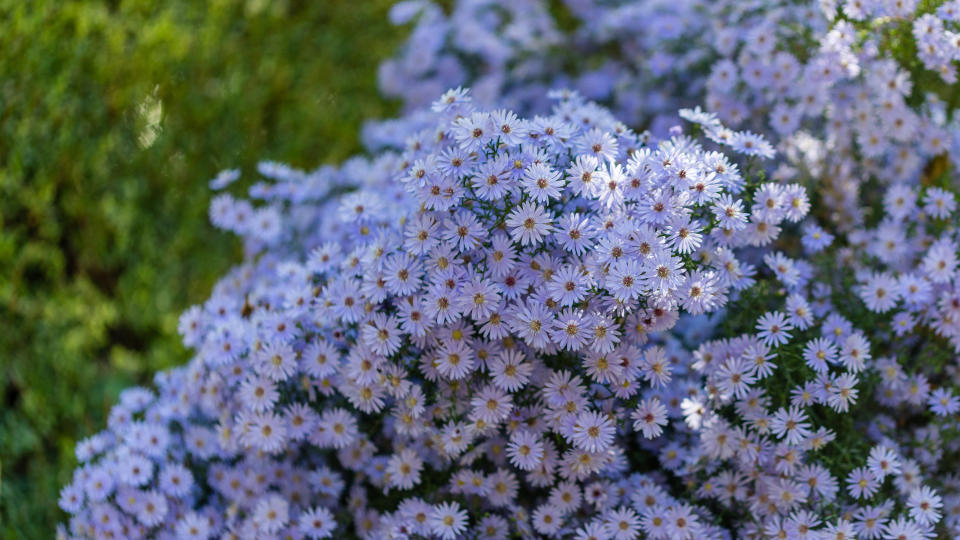
Asters are a popular autumn plant, often used as seasonal décor in landscapes and on porches and patios. (Click through for 4 easy ways to pretty up a patio.) But the frost-hardy, spiky-petaled pretties are actually butterfly magnets! Blue Wood Asters are one of the last plants to stay flowering in a butterfly garden in fall, serving as a vital food source for our fluttering friends. As their blooms are pollinated, the button-like centers of Blue Wood Asters turn to from yellow to a shade of mauve, letting pollinators know where they need to focus their attention.
USDA Hardiness Zones: 3–10
Soil conditions: Average to moist well-draining soil
Sun requirements: Give full sun to part shade
Watering schedule: Water once weekly or when the top inch of soil is dry
Zigzag Goldenrod (Solidago flexicaulis)
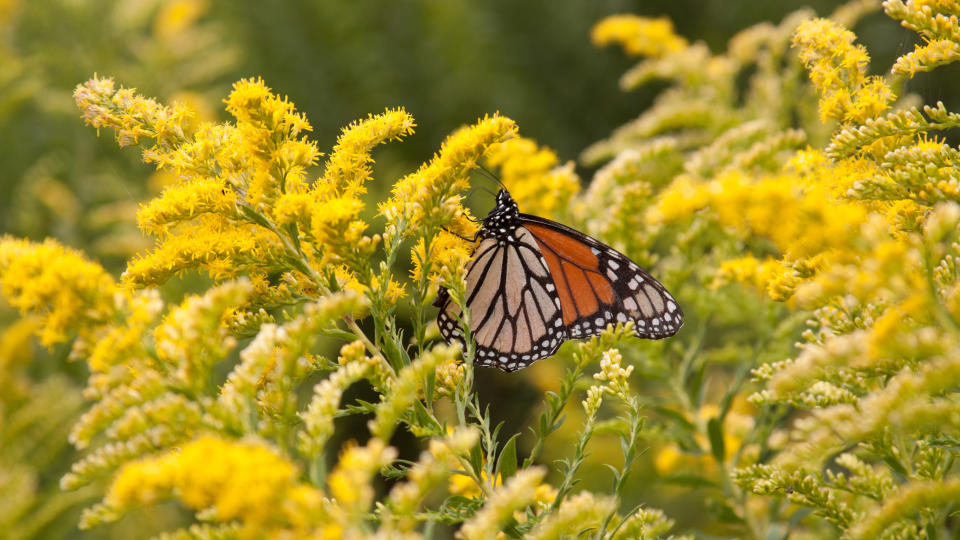
Zigzag Goldenrod adds sunny color and textural interest to flower beds with its bright yellow flowers that grow in a zig-zag-like pattern up their stems. The plant reaches heights of up 12 to 36 inches tall and blooms in late summer, with flowers lasting into early fall. Butterflies like Sulphurs, Coppers and Monarchs use the plant as a nectar-rich food source, as well as many other pollinators like bees and moths.
USDA Hardiness Zones: 3–8
Soil conditions: Medium moist, well-draining soil
Sun requirements: Give full sun to part shade
Watering schedule: Water when the top 3 inches of soil is dry
Wild Bergamot (Monarda fistulosa)

Not only does this plant provide a beautiful burst of pink-to-lavender, pompom-like blooms from mid-summer to early fall, but it also adds a welcoming, citrusy aroma to your outdoor space! Swallowtail butterflies especially love drinking the nectar from the plant's blooms, and its leaves are an important caterpillar food source. Wild Bergamot can grow 24 to 48 inches tall and up to 36 inches wide, so be sure to give plants plenty of space between one another when planting.
USDA Hardiness Zones: 3–8
Soil conditions: Medium moist soil
Sun requirements: Give full sun to light shade
Watering schedule: Water once weekly
Sunflower (Helianthus annus)
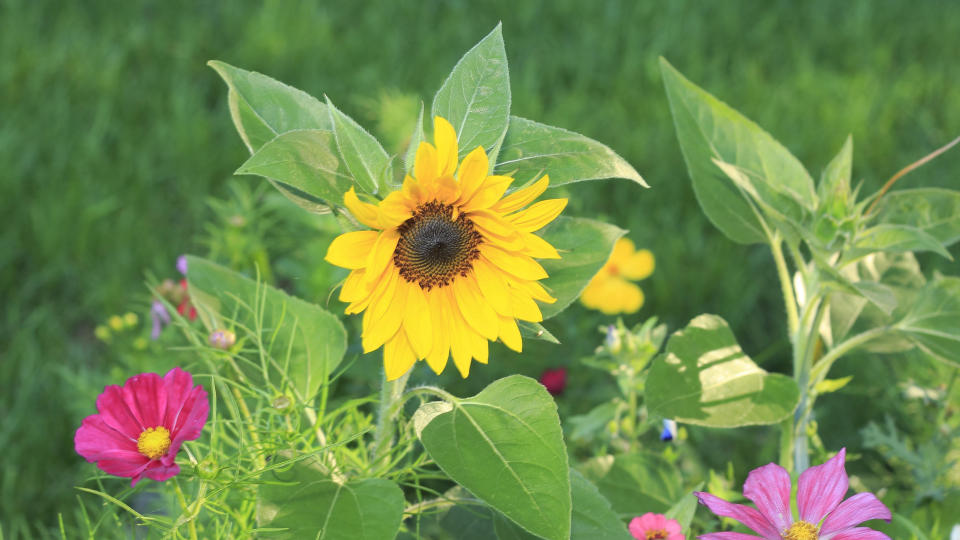
Nothing welcomes the late summer and early fall like happy-hued, button-centered sunflowers! The foliage on the sturdy and sunny blooms make them attractive host plants for Bordered Patch and Checkerspot butterflies, and their sweet nectar is a favorite among Cabbage White and Sulphur butterflies. Because sunflowers grow anywhere from 5 to 10 feet high, they are beautiful along a fence or in the back of a border planting. Once the blooms fade, their seed-filled centers feed a wide variety of birds. Love sunflowers? See why one family planted 2 million of the beautiful blooms!
USDA Hardiness Zones: 2–11
Soil conditions: Well-draining soil
Sun requirements: Give full sun
Watering schedule: Water when top inch of soil is dry
Looking for more gardening advice? Check out these stories!
5 Simple Tips for Growing a Healthy Vegetable Garden at Home
Front Yard Face Lift — Do These 4 Things To Make Your Garden Gorgeous
12 Surprising Ways To Keep Rabbits Out Of Your Garden Without a Fence
Solve the daily Crossword

